Formaldehyde Gas Sensing Characteristics of ZnO-TiO2 Gas Sensors
Abstract
1. Introduction
2. Materials and Methods
2.1. Sensor Fabrication
2.2. ZnO-TiO2 Composite Gas Sensor Nanostructure Fabrication
2.3. Sensitivity Measurement of Gas Sensors
2.4. Characteristics and Principles of Gas Sensors
3. Results and Discussion
3.1. Structural Analysis of ZnO-TiO2 Composite Gas Sensor
3.1.1. Surface Analysis of ZnO-TiO2 Composite Gas Sensor Using FE-First
3.1.2. Component Analysis of ZnO-TiO2 Composite Gas Sensor Using XRD
3.2. Evaluation of Sensitivity Characteristics of ZnO-TiO2 Composite Gas Sensor Schemes
3.2.1. Evaluation of Sensitivity and Recovery According to the Ratio of TiO2 to Formaldehyde Gas
3.2.2. Comparison of the Difference in Sensitivity and Recovery According to the Ratio of TiO2 to Formaldehyde Gas and Toluene Gas
4. Conclusions
- At high concentrations of formaldehyde gas (20, 10, 5 ppm), samples A, B, C, and D all showed similar patterns, and the lower the concentration, the lower the sensitivity. However, in Sample A, at 10 ppm and 5 ppm, aa sensitivity which was about 20–30% lower than the other samples was measured.
- At low concentrations of formaldehyde gas (1, 0.5, 0.1 ppm), the lower the concentration in samples C and D, the lower the sensitivity. Since this has selectivity for each formaldehyde gas concentration, samples C and D are more suitable as gas sensors than samples A and B in low concentration discrimination.
- When compared at 20 ppm of formaldehyde and toluene gas, the difference in sensitivity between samples A and D was about 15–20%, and the difference in sensitivity between samples B and C was about 40% or more. Samples B and C have selectivity for formaldehyde and toluene gas at 20 ppm standard and are more suitable as gas sensors.
- When compared at 0.1 ppm of formaldehyde and toluene gas, samples B and C showed a sensitivity difference of about 5% or more, and samples A and D showed almost no difference in sensitivity. Samples B and C have selectivity for formaldehyde and toluene gas at 0.1 ppm standard and are more suitable as gas sensors.
- When both the detection characteristics by formaldehyde gas concentration and the detection characteristics when comparing formaldehyde and toluene gas are considered, Sample C (ZnO(99%)-TiO2(1%)) showed the difference in sensitivity for each condition and showed the selectivity. When investigating the characteristics, it was confirmed that it is more suitable as a gas sensor than other samples.
Author Contributions
Funding
Institutional Review Board Statement
Informed Consent Statement
Data Availability Statement
Conflicts of Interest
References
- Taurino, A.M.; Epifani, M.; Tocoli, T.; Iannotta, S.; Siciliano, P. Innovative aspecs in thin film technologies for nanostructured materials in gas sensor device. Thin Solid Film 2003, 436, 137–140. [Google Scholar] [CrossRef]
- Kim, Y.J.; Park, S.Y.; Lee, J.S.; Lee, S.H.; Woo, K.W.; Lee, S.H.; Lee, M.S. Low-temperature operation, high-sensitivity, high-selectivity NO2 gas sensor using SnO2 nanowires. J. Korean Soc. Sens. 2021, 30, 175–180. [Google Scholar]
- Saukko, S.; Lantto, V. Influence of electrode material on properties of SnO2-based gas gensor. Thin Solid Film 2003, 436, 52–63. [Google Scholar] [CrossRef]
- Wu, Q.; Lee, K.; Liu, C.C. Development of chemical sensor using microfabrication and micromachining techniques. Sens. Actuators B 1993, 14, 1–6. [Google Scholar] [CrossRef]
- Simon, I.; Barsan, N.; Bauer, M.; Weimar, U. Micromachined metal oxide gas sensors: Opportunities to improve sensor performance. Sens. Actuators B Chem. 2001, 73, 1–26. [Google Scholar] [CrossRef]
- Koh, Y.M.; Ahn, S.K.; Sung, M.K.; Lee, S.M.; Min, Y.S.; Oh, J.G.; Kim, Y.S. Measurement and evaluation of HCHO and VOCs emission characteristics of wallpaper for new apartment houses. J. Korean Soc. Living Environ. 2007, 14, 376–383. [Google Scholar]
- Horrillo, M.C.; Getierrez, J.; Sayago, I. Measurements of VOCs in soils through a tin oxide multisensor system. Sens. Actuators 1997, 43, 193. [Google Scholar] [CrossRef]
- Kim, M.K.; Park, Y.S.; Jeung, Y.J. A study on the measurement of VOCs and the effects of VOCs on the human body—Analysis of THMs in tap water in 6 major cities in Korea. Anal. Sci. 2000, 13, 55–65. [Google Scholar]
- Lee, K.H.; Lee, J.H. Special Feature: Latest Development Trends in Sensor Materials Research Trends for Indoor Air Quality Gas Sensors Using Oxide Semiconductors. Korean Ind. Chem. News 2020, 23, 32–41. [Google Scholar]
- Skoog, D.A. Principles of Instrumental Analysis; Saunders College Publishing: Mankato, MN, USA, 1985; pp. 315–361. [Google Scholar]
- Kim, J.O.; Kim, D.S.; Lee, W.S. A Comparison of Gas Sensor. In Proceedings of the Characteristic Comparison of Gas Sensors, Korean Society of Electronics Engineers Conference, Samseong-dong COEX, Seoul, Republic of Korea, 7–8 November 2016; pp. 2088–2091. [Google Scholar]
- Yamzoe, N. New approaches for improving semiconductor gas sensors. Sens. Actuators B 1991, 5, 7–19. [Google Scholar] [CrossRef]
- Tang, W.; Wang, J. Mechanism for toluene detection of flower-like ZnO sensors prepared by hydrothermal approach: Charge transfer. Sens. Actuators B Chem. 2015, 207, 66–73. [Google Scholar] [CrossRef]
- Savage, N.; Chwieroth, B.; Ginwalla, A.; Pattonm, B.; Akbar, S.; Dutta, D. Composite n-p semiconducting titanium oxided as gas sensors. Sens. Actuators B 2001, 79, 17–27. [Google Scholar] [CrossRef]
- Choi, D.H. ZnO-based Ethanol Gas Sensor. J. Sens. Sci. Technol. 2013, 22, 444–449. [Google Scholar] [CrossRef]
- Zhu, L.; Zeng, W. Room-temperature gas sensing of ZnO-based gas sensor: A review. Sens. Actuators A Phys. 2017, 267, 242–261. [Google Scholar] [CrossRef]
- Yang, P.; Yan, H.; Mao, S.; Russo, R.; Johnson, J.; Saykally, R.; Morris, N.; Pham, J.; He, R.; Choi, H.J. Controlled growth of ZnO nanowires and their optical properties. Adv. Funct. Mater. 2002, 12, 323. [Google Scholar] [CrossRef]
- Sun, Y.; Fuge, G.; Ashfold, M.N.R. Growth mechanisms for ZnO nanorods formed by pulsed laser deposition. Superlattices Microstruct. 2006, 39, 33. [Google Scholar] [CrossRef]
- Greene, L.E.; Law, M.; Goldberger, J.; Kim, F.; Johnson, J.C.; Zhang, Y.; Saykally, R.J.; Yang, P. Low temperature wafer—Scale production of ZnO nanowire arrays. Angew. Chem. Int. Ed. 2003, 42, 3031. [Google Scholar] [CrossRef] [PubMed]
- Li, Z.; Xiong, Y.; Xie, Y. Selected-control synthesis of ZnO nanowires and nanorods via a PEG-assisted route. Inorg. Chem. 2003, 42, 8105. [Google Scholar] [CrossRef]
- Birkin, P.R.; Power, J.F.; Leighton, T.G.; Vincü otte, A.M.L. Cathodic electrochemical detection of sonochemical radical products. Anal. Chem. 2002, 74, 2584. [Google Scholar] [CrossRef] [PubMed]
- Wattanawikkam, C.; Pecharapa, W. Synthesis and Characterization of Zn-Doped TiO2 Nanoparticles via Sonochemical Method. Integr. Ferroelectr. 2015, 165, 167–175. [Google Scholar] [CrossRef]
- Bhanvase, B.A.; Veer, A.; Shirsath, S.R.; Sonawane, S.H. Ultrasound assisted preparation, characterization and adsorption study of ternary chitosan-ZnO-TiO2 nanocomposite: Advantage over conventional method. Ultrason. Sonochemistry 2019, 52, 120–130. [Google Scholar] [CrossRef]
- Park, S.M.; Zang, S.L.; Huh, J.S. NO Sensing Characteristics of ZnO Nanorod Prepared by Ultrasound Radiation Method. Korean J. Mater. Res. 2008, 18, 367–372. [Google Scholar] [CrossRef]
- Kiyoshi, T. Sehwa. In Sensor Dictionary; Ryong, P., Ed.; Saehwa Publishing Company: Paju, Gyeonggi-do, Republic of Korea, 1998. [Google Scholar]
- Mason, T.J. An Introduction to the Uses of Power Ultrasound in Chemistry, in Sonochemistry; Oxford University Press: Oxford, UK, 1999; pp. 1–41. [Google Scholar]
- Kwon, D.H. Analysis of the Response Characteristics of Toluene Gas Sensors with a ZnO Nanorod Structure by a Heat Treatment Process. Sensors 2022, 22, 4125. [Google Scholar] [CrossRef] [PubMed]
- Manikandan, V.; Vigneselvan, S.; Iulian, P.; Rajaram, S.M.; Ajeet, S.; Kamil, S.; Chandrasekaran, J. Long-lasting stability and low-concentration SO2 gas detection aptitude of Sn-doped alumina sensors. Mater. Chem. Phys. 2022, 291, 126691. [Google Scholar]
- Lee, J.H.; Lim, S.H. Review on Sensor Technology to Detect Toxic Gases. J. Sens. Sci. Technol. 2015, 24, 311–318. [Google Scholar] [CrossRef]
- Yoon, J.H.; Lee, H.J.; Kim, J.S. Formaldehyde Gas-Sensing Characteristics of SnO2-ZnO Materials. Korean J. Met. Mater. 2009, 48, 169–174. [Google Scholar] [CrossRef]
- Chen, D.; Yuan, Y.J. Thin-Film Sensors for Detection of Formaldehyde: A Review. IEEE Sens. J. 2015, 15, 6749–6760. [Google Scholar] [CrossRef]
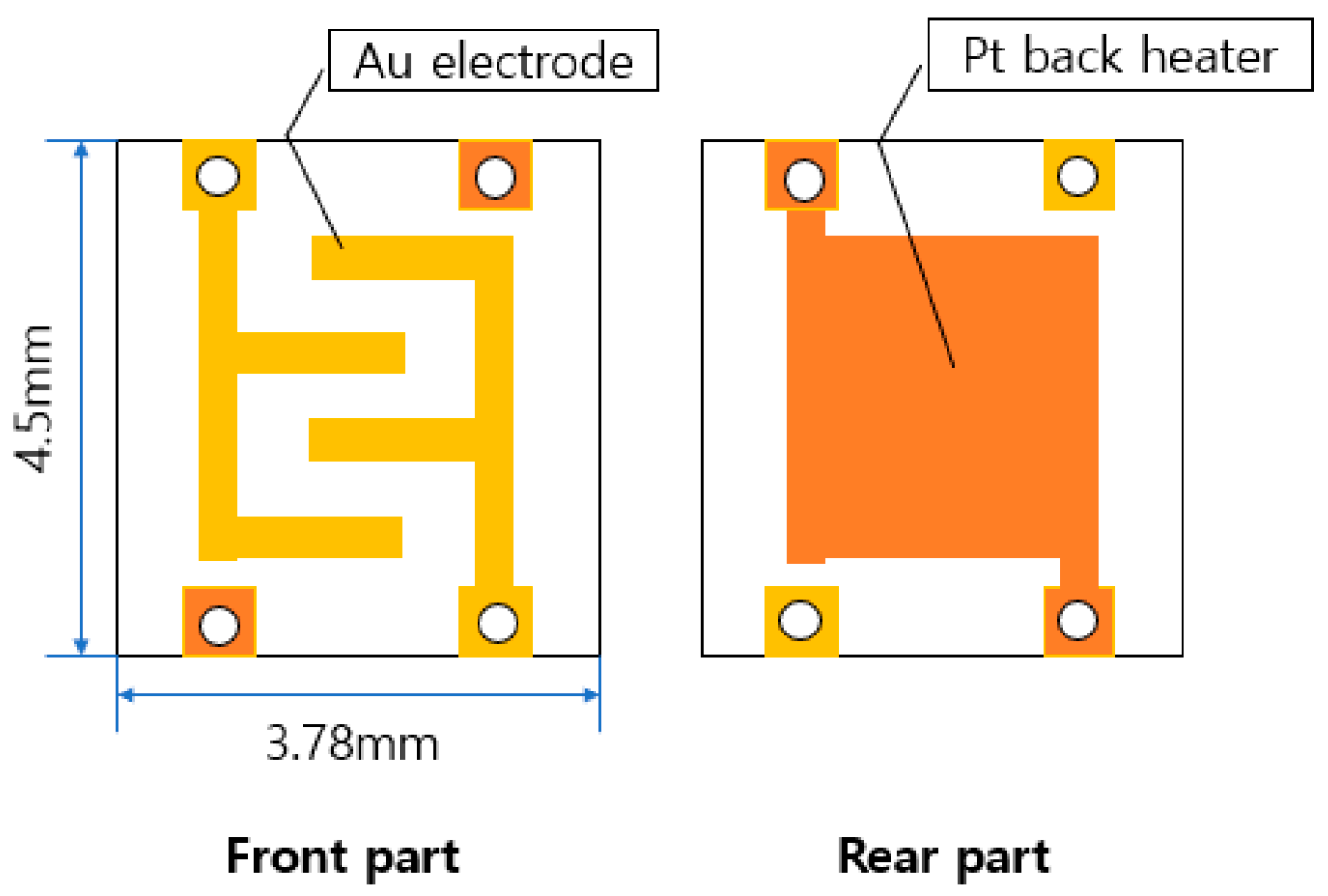
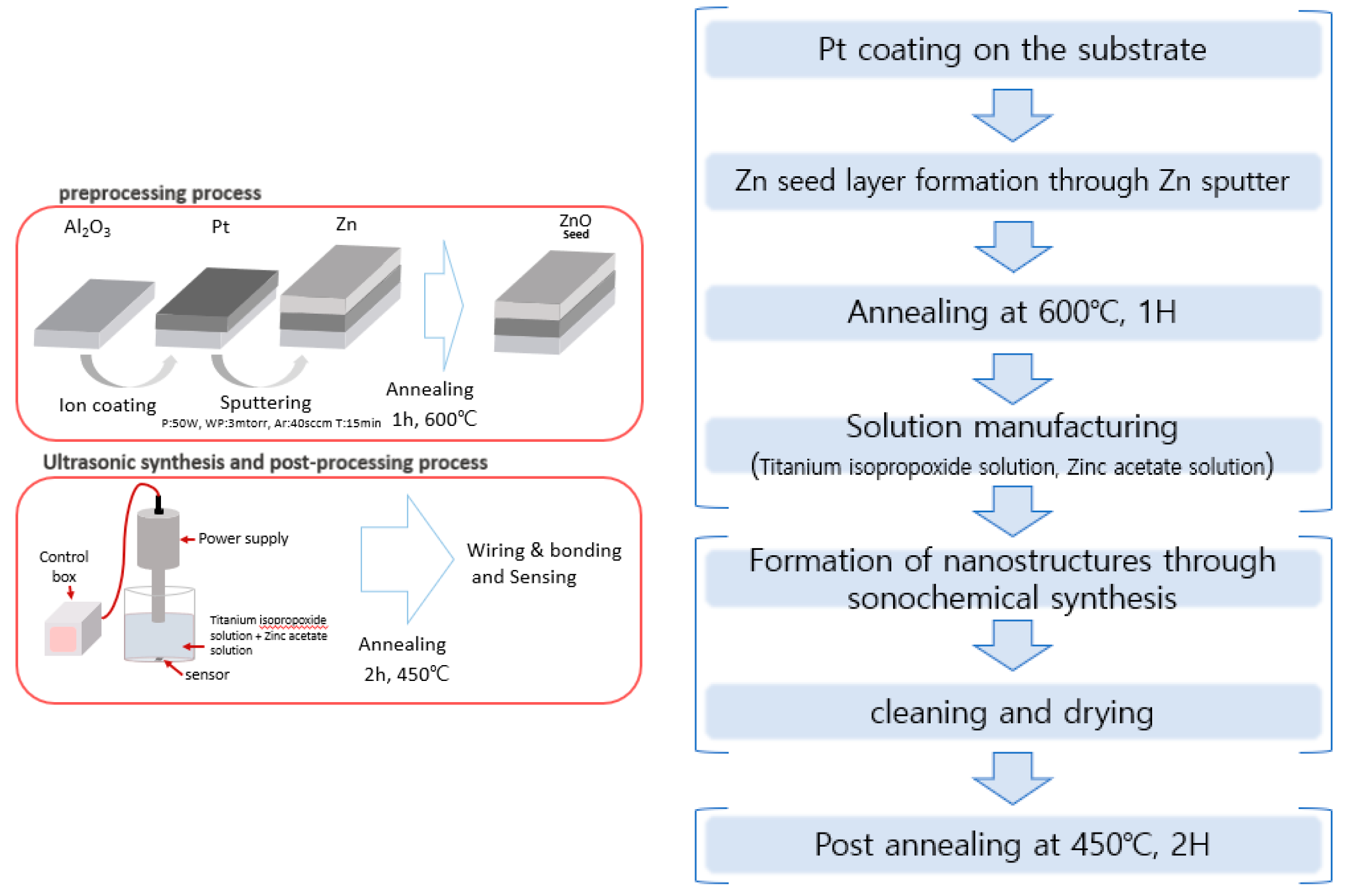

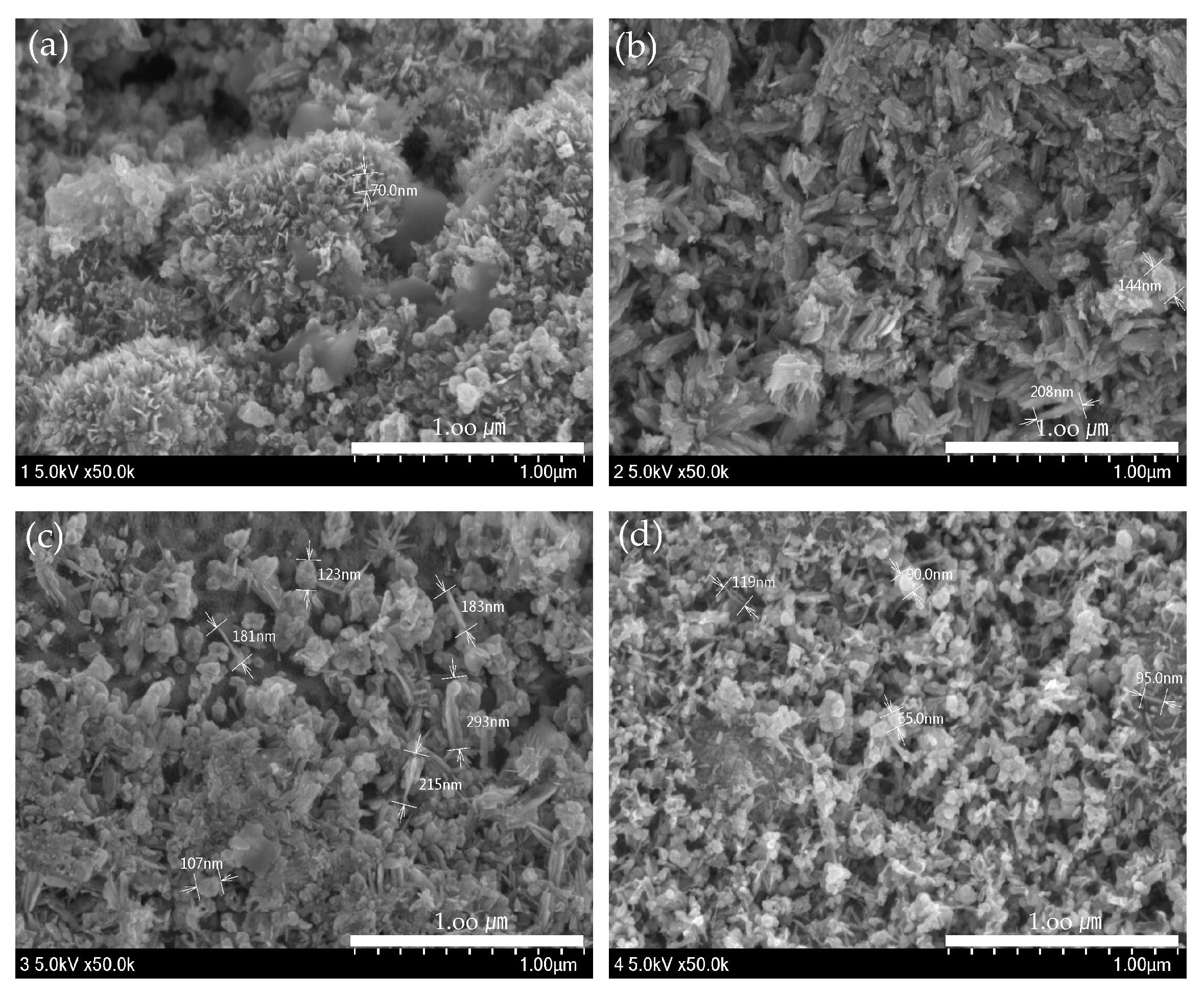
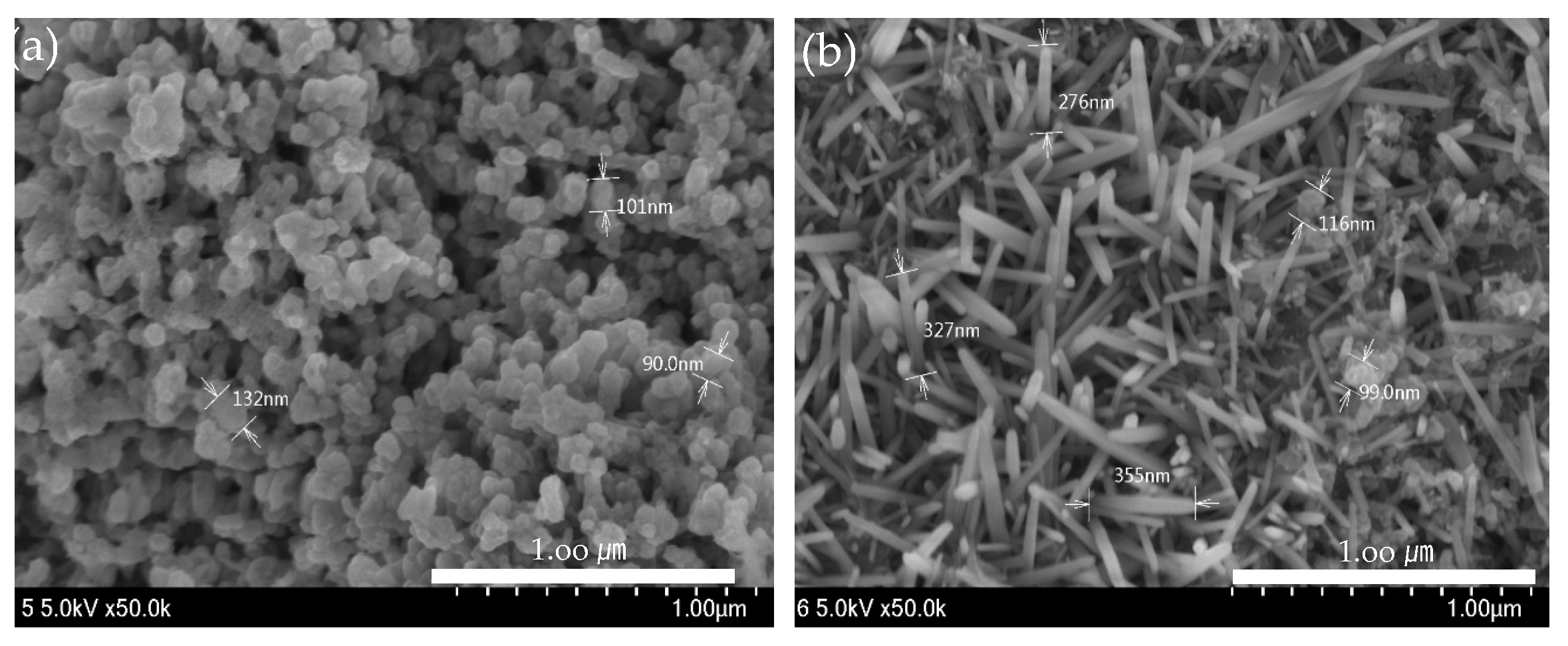
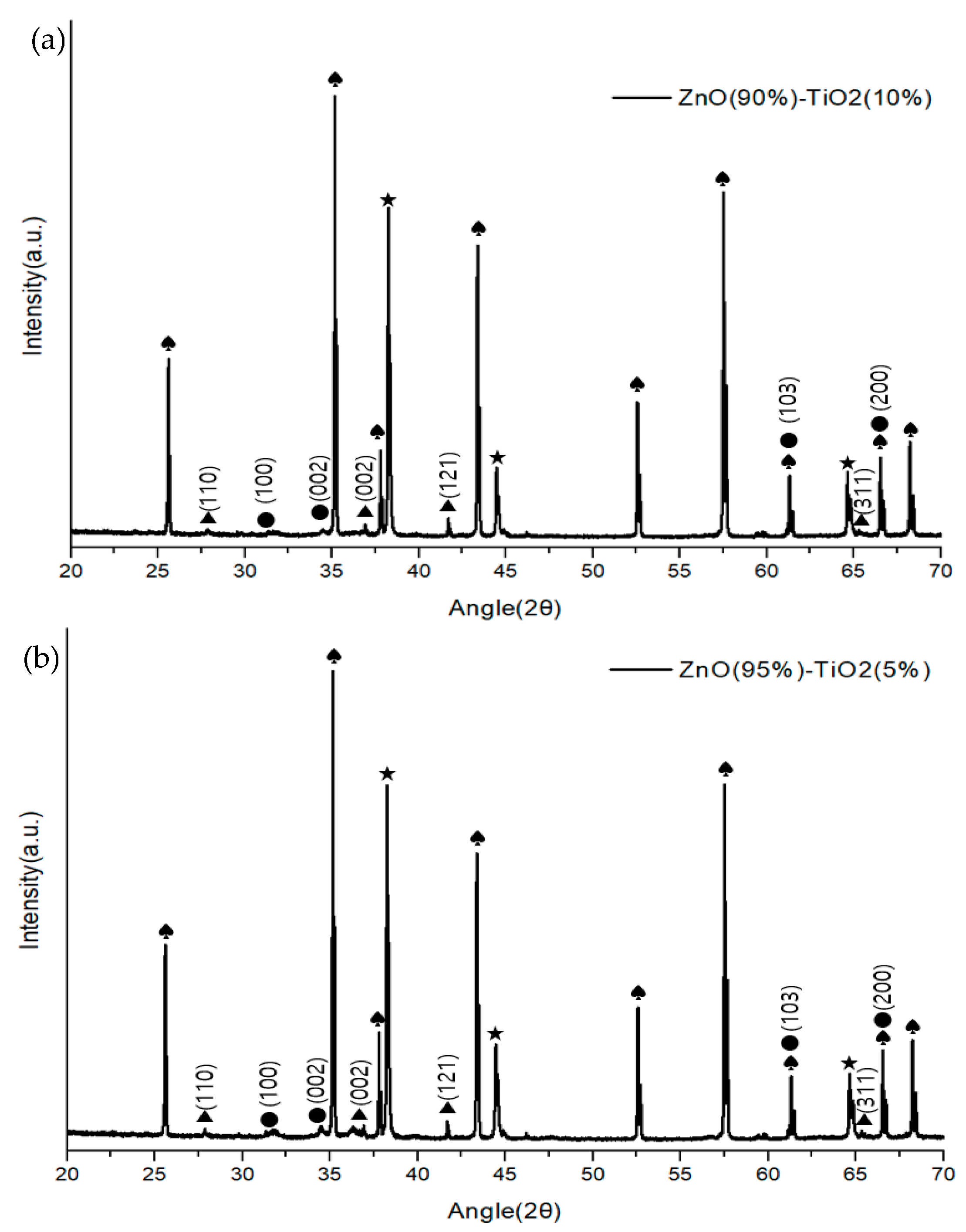
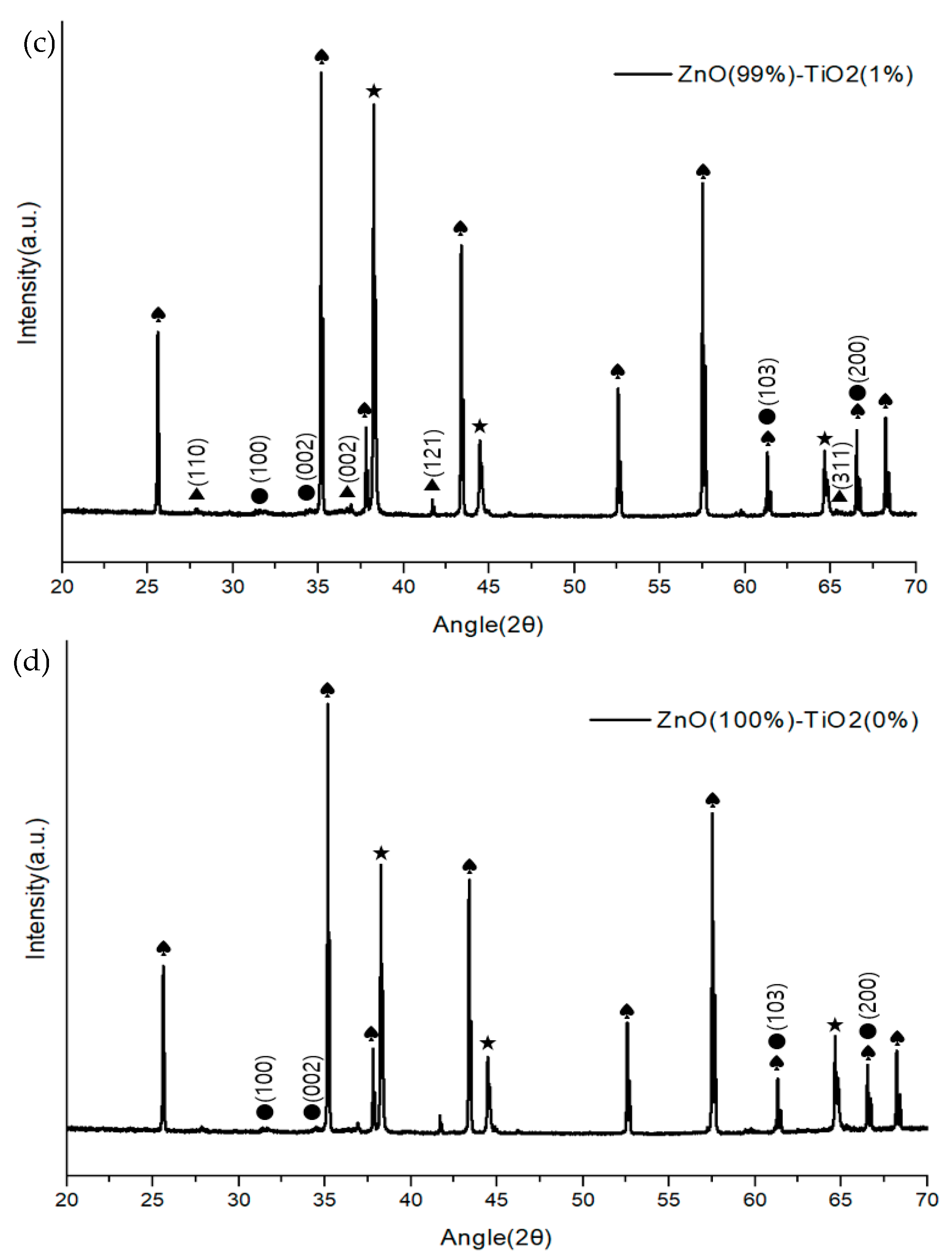
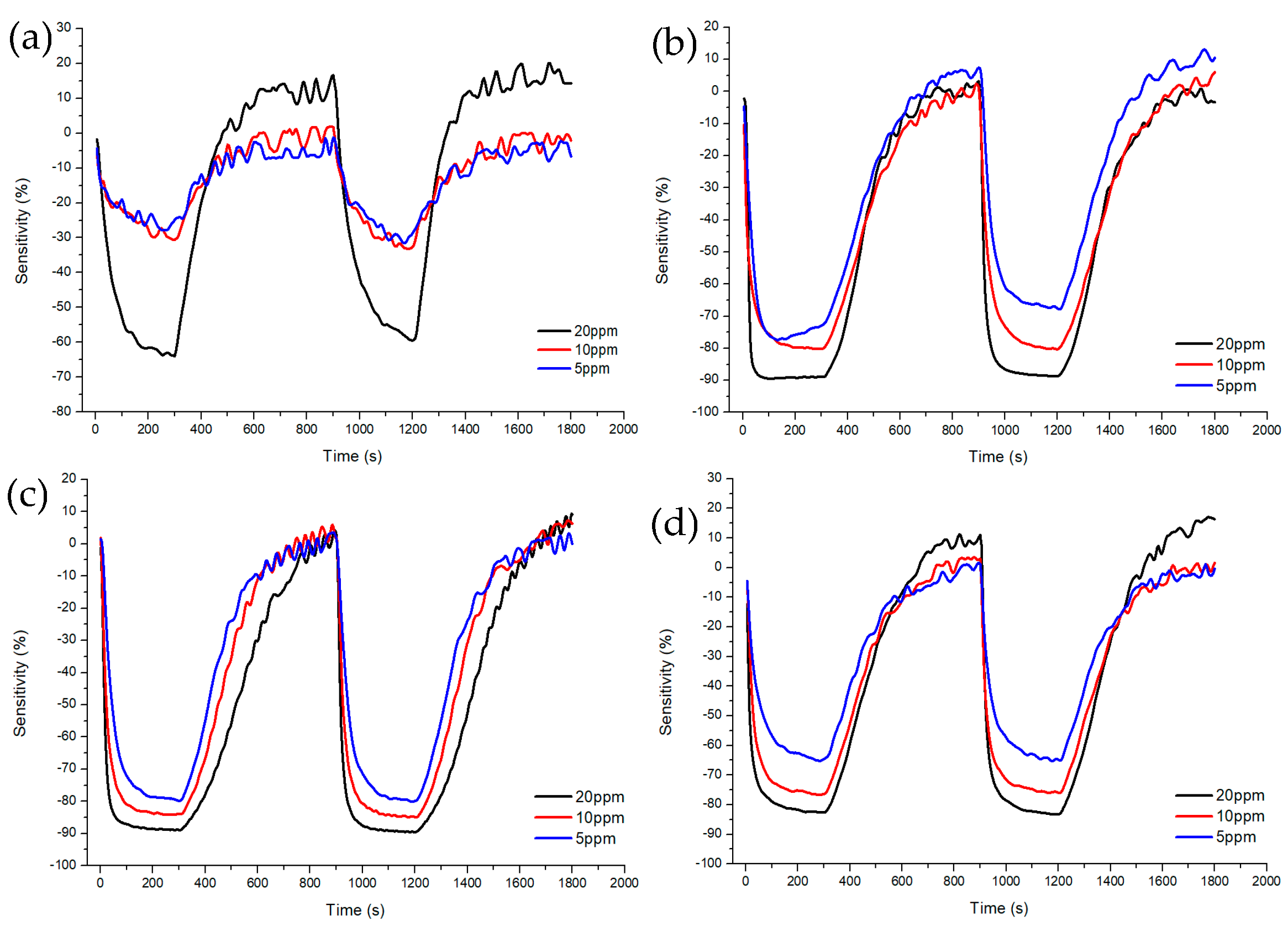


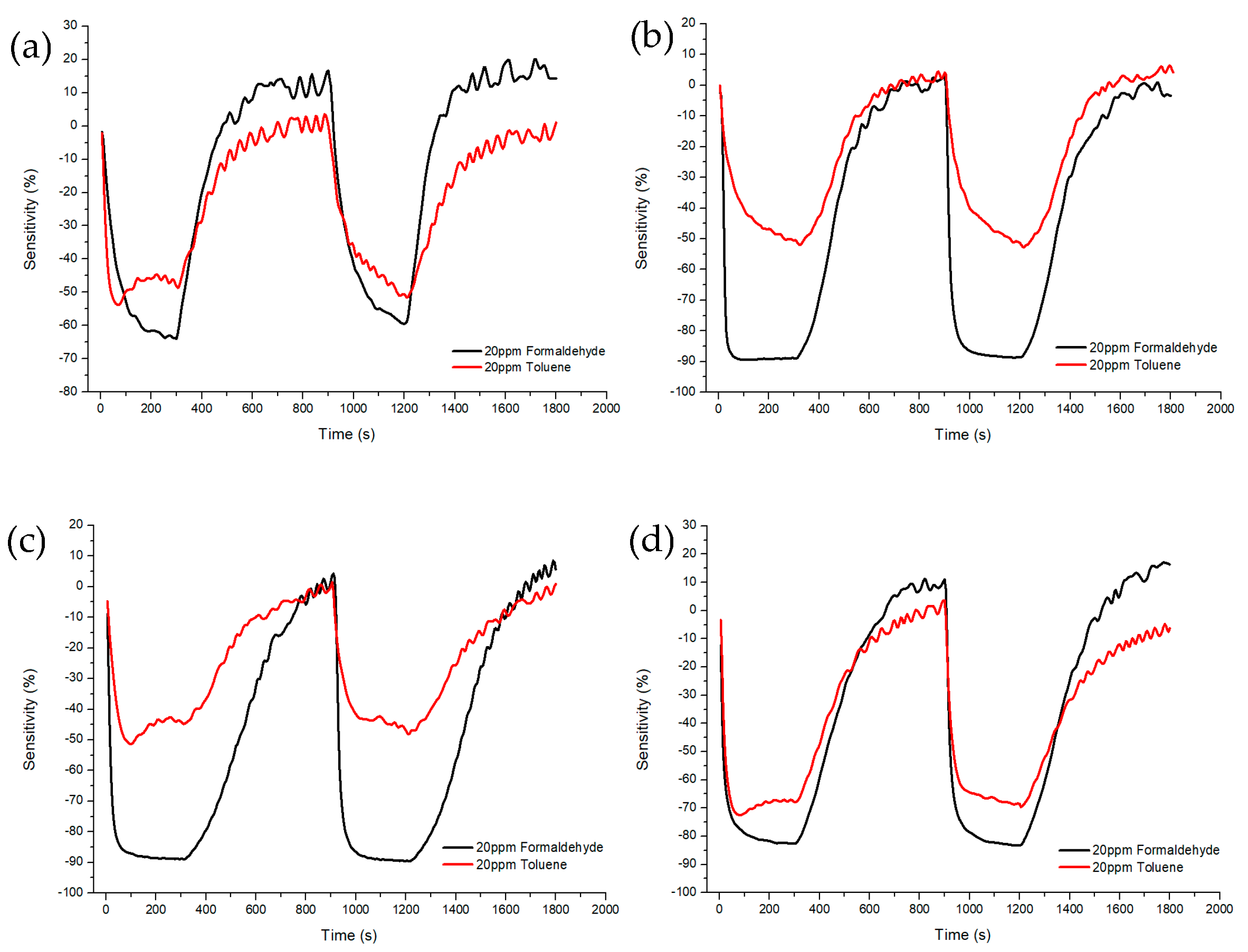

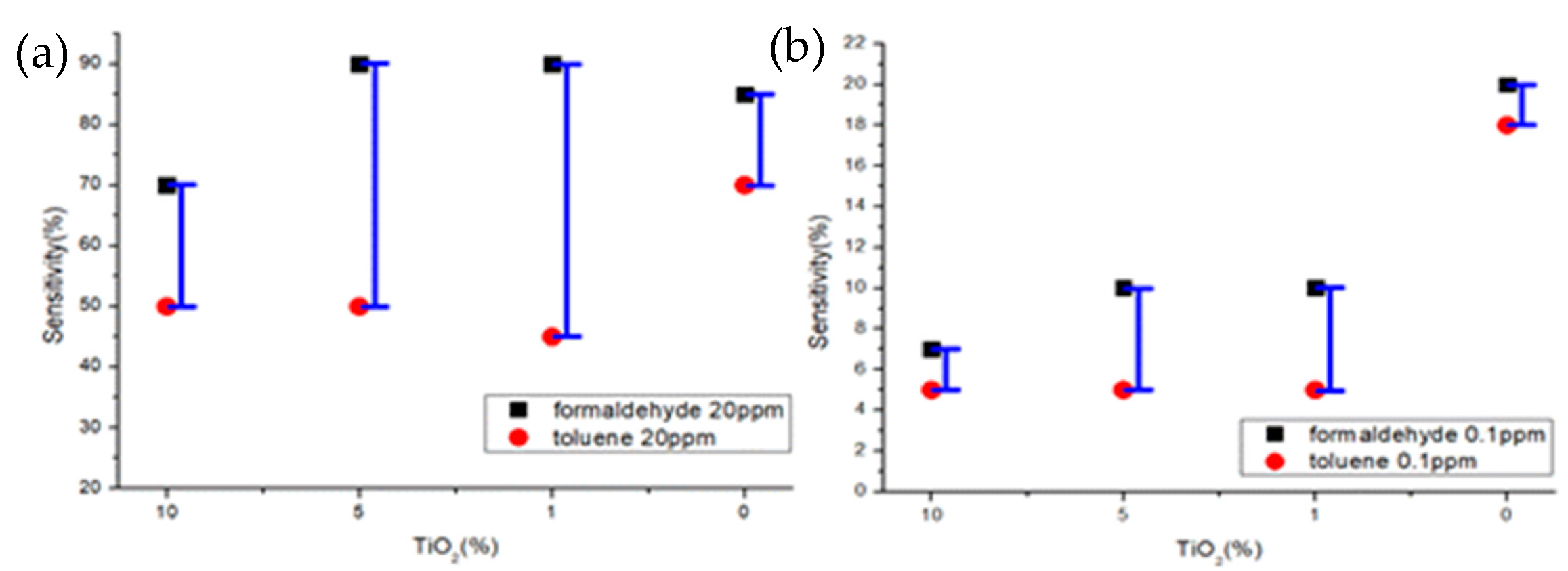
| A | B | C | D | |
|---|---|---|---|---|
| ratio | ZnO(90%)-TiO2(10%) | ZnO(95%)-TiO2(5%) | ZnO(99%)-TiO2(1%) | ZnO(100%)-TiO2(0%) |
| Sensor Type | Formaldehyde (ppm) | Sensitivity(%) | Response Time (s) | Recovery Time(s) |
|---|---|---|---|---|
| ZnO(90%)-TiO2(10%) | 20 | 63.9 | 150 | 250 |
| 10 | 30.5 | 200 | 285 | |
| 5 | 27.7 | 150 | 290 | |
| 1 | 10.8 | 135 | 110 | |
| 0.5 | 10.1 | 120 | 110 | |
| 0.1 | 9.8 | 125 | 110 | |
| ZnO(95%)-TiO2(5%) | 20 | 89.1 | 30 | 300 |
| 10 | 80.1 | 70 | 305 | |
| 5 | 77.1 | 75 | 310 | |
| 1 | 23.4 | 100 | 265 | |
| 0.5 | 20.5 | 155 | 310 | |
| 0.1 | 10.8 | 160 | 320 | |
| ZnO(99%)-TiO2(1%) | 20 | 88.9 | 35 | 440 |
| 10 | 83.8 | 55 | 320 | |
| 5 | 79.8 | 95 | 320 | |
| 1 | 32.9 | 100 | 280 | |
| 0.5 | 20.7 | 105 | 310 | |
| 0.1 | 13.5 | 105 | 330 | |
| ZnO(100%)-TiO2(0%) | 20 | 86.6 | 50 | 300 |
| 10 | 76.3 | 75 | 345 | |
| 5 | 64.6 | 105 | 385 | |
| 1 | 44.1 | 150 | 390 | |
| 0.5 | 32.6 | 170 | 390 | |
| 0.1 | 22.7 | 180 | 395 |
| Sensor | Temperature (°C) | Formaldehyde (ppm) | Sensitivity | Ref. |
|---|---|---|---|---|
| SnO2(95%)-ZnO(5%) | 350 | 1 | 35 | [30] |
| Ag doped TiO2 | 360 | 200 | 3.7 | [31] |
| Shuttle-like ZnO nano/microrods | 400 | 10 | 24.8 | [31] |
| Nanoparticle-assembled ZnO mico-octahedrons | 400 | 1 | 22.7 | [31] |
| ZnO nanotetrapods | 320 | 5 | ~8 | [31] |
| ZnO(99%)-TiO2(1%) | 250 | 1 | 32.9 |
Disclaimer/Publisher’s Note: The statements, opinions and data contained in all publications are solely those of the individual author(s) and contributor(s) and not of MDPI and/or the editor(s). MDPI and/or the editor(s) disclaim responsibility for any injury to people or property resulting from any ideas, methods, instructions or products referred to in the content. |
© 2023 by the authors. Licensee MDPI, Basel, Switzerland. This article is an open access article distributed under the terms and conditions of the Creative Commons Attribution (CC BY) license (https://creativecommons.org/licenses/by/4.0/).
Share and Cite
Park, J.; Lee, J.; Choi, M.S.; Huh, J.-S. Formaldehyde Gas Sensing Characteristics of ZnO-TiO2 Gas Sensors. Chemosensors 2023, 11, 140. https://doi.org/10.3390/chemosensors11020140
Park J, Lee J, Choi MS, Huh J-S. Formaldehyde Gas Sensing Characteristics of ZnO-TiO2 Gas Sensors. Chemosensors. 2023; 11(2):140. https://doi.org/10.3390/chemosensors11020140
Chicago/Turabian StylePark, Jaebum, Jihoon Lee, Myung Sik Choi, and Jeung-Soo Huh. 2023. "Formaldehyde Gas Sensing Characteristics of ZnO-TiO2 Gas Sensors" Chemosensors 11, no. 2: 140. https://doi.org/10.3390/chemosensors11020140
APA StylePark, J., Lee, J., Choi, M. S., & Huh, J.-S. (2023). Formaldehyde Gas Sensing Characteristics of ZnO-TiO2 Gas Sensors. Chemosensors, 11(2), 140. https://doi.org/10.3390/chemosensors11020140






